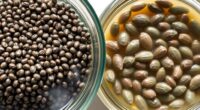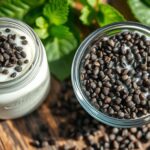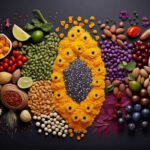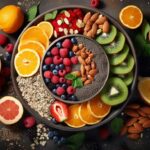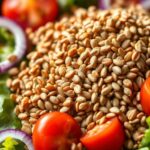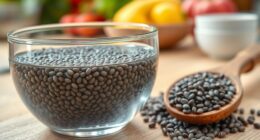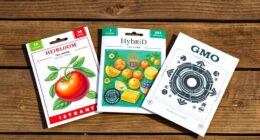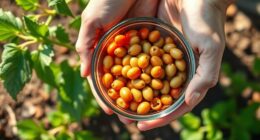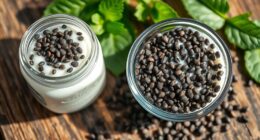Making probiotic chia yogurt at home is easy and fun. Simply soak chia seeds in milk, add probiotic capsules or starter culture, and let it ferment at 70-75°F for 12-24 hours. This process develops a tangy flavor while boosting your probiotic intake, supporting gut health. Once finished, stir well, refrigerate, and enjoy alone or with your favorite toppings. Want to master each step? Keep exploring for expert tips and tricks.
Key Takeaways
- Combine soaked chia seeds with milk and add probiotic capsules or starter culture to initiate fermentation.
- Maintain a temperature of 70-75°F (21-24°C) for 12-24 hours to develop tangy flavor and probiotic benefits.
- Stir the mixture thoroughly after fermentation and refrigerate to preserve probiotics and slow fermentation.
- Customize your probiotic chia yogurt with toppings like fruit, nuts, or honey for added flavor and nutrition.
- Making it at home ensures control over ingredients, enhances flavor, and provides a nutritious, probiotic-rich snack.
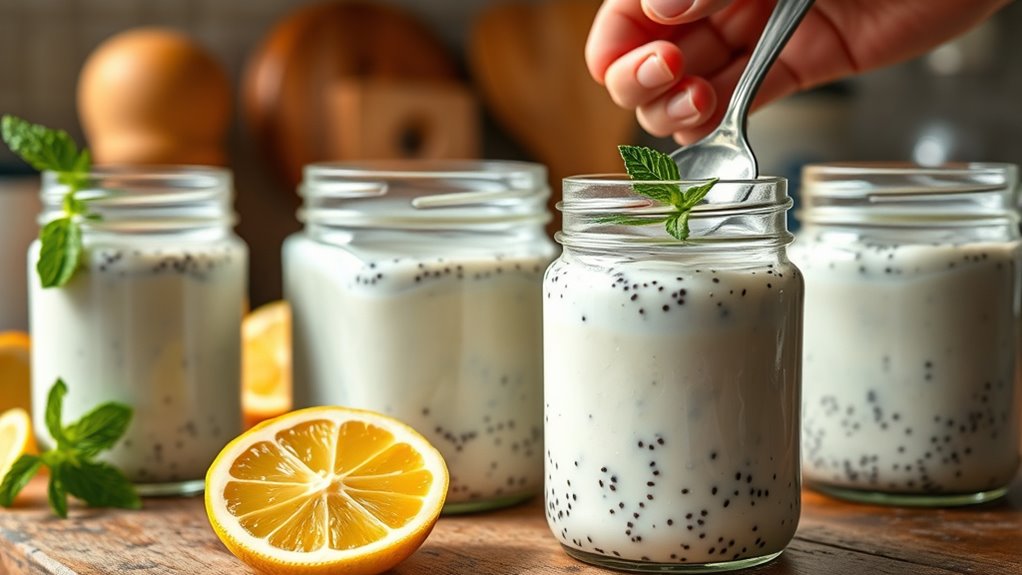
Have you ever wondered how simple ingredients transform into tangy, flavorful foods through fermentation? This process isn’t just about creating delicious treats; it’s also about harnessing the power of probiotics to boost your health. One exciting way to do this at home is by making your own probiotic chia yogurt, a tasty and nutrient-dense cultured dairy product that supports your probiotic health. Unlike store-bought options, homemade chia yogurt allows you to control the ingredients, ensuring it’s free from additives or preservatives. Plus, it’s a fun project that turns ordinary pantry staples into a probiotic-rich snack.
To start, you’ll need a few basic ingredients: chia seeds, milk (dairy or plant-based), a probiotic starter or capsules, and a sweetener if desired. The process begins with soaking the chia seeds in your chosen milk. The seeds absorb the liquid, forming a gel-like consistency that creates a creamy base. Next, you introduce the probiotic culture—either by opening probiotic capsules and mixing their contents into the milk or using a probiotic starter culture designed for dairy fermentation. This is where the magic of fermentation kicks in; the beneficial bacteria begin to ferment the sugars in the milk and chia mixture, producing lactic acid that thickens the yogurt and imparts a tangy flavor.
Start by soaking chia seeds in milk, then add probiotics to ferment into tangy, probiotic-rich yogurt.
Fermentation is a fascinating biological process that enhances not only the flavor but also the nutritional profile of your chia yogurt. The probiotics work to break down complex nutrients, making them easier to digest and increasing the bioavailability of vitamins and minerals. This cultured dairy product becomes a powerhouse of probiotic health, supporting your gut microbiome and overall immune function. It’s important to keep the mixture at a warm, stable temperature during fermentation—about 70-75°F (21-24°C)—for 12 to 24 hours, depending on how tangy you want it. The longer it ferments, the more pronounced the flavor and probiotic benefits. Additionally, understanding risk mitigation techniques can help ensure your fermentation process is safe and successful.
Once fermentation is complete, give your chia yogurt a good stir and refrigerate it. The cold slows down the fermentation process and preserves the beneficial bacteria. You can enjoy it plain, or top it with fresh fruit, nuts, or honey for added flavor and texture. Making probiotic chia yogurt at home isn’t just satisfying; it’s a simple way to incorporate cultured dairy into your diet and support your probiotic health naturally. With a little patience and experimentation, you’ll soon be savoring your own tangy, nourishing creation, knowing exactly what’s in it and reaping the benefits of fermentation.
Frequently Asked Questions
How Long Does Homemade Probiotic Chia Yogurt Last?
You might wonder how long homemade probiotic chia yogurt lasts. Typically, its storage duration is about 5 to 7 days in the fridge. Keep an eye out for spoilage indicators like foul smell, mold, or sliminess. Properly stored in an airtight container, it stays fresh longer. If it develops any off smells or unusual textures, it’s best to discard it to avoid health risks.
Can I Use Different Sweeteners in the Recipe?
You can definitely use alternative sweeteners to customize the flavor of your probiotic chia yogurt. Options like honey, maple syrup, agave, or stevia work well, giving you flexibility for flavor preferences or dietary needs. Just keep in mind that some sweeteners might affect fermentation slightly or alter the texture, so start with small amounts and adjust to taste to guarantee your yogurt remains delicious and probiotic-friendly.
Is It Safe to Ferment in Plastic Containers?
You might wonder if it’s safe to ferment in plastic containers. While plastic can be convenient, it’s not always the best choice for fermentation safety, as some plastics may leach chemicals over time. For best results, opt for glass or food-grade ceramic containers, which are non-reactive and safer for fermentation. This helps guarantee your probiotic chia yogurt stays healthy, safe, and free from unwanted chemicals.
What Are Signs of Spoilage in Fermented Chia Yogurt?
Like a detective sniffing out clues, you should watch for signs of spoilage in your fermented chia yogurt. If it develops an off smell, mold, or slimy texture, it’s time to toss it—these are clear indicators of spoilage. Remember, the shelf life varies, but mold detection is vital to guarantee safety. When in doubt, trust your senses; if it looks or smells wrong, discard it.
Can I Add Fruit or Flavorings After Fermentation?
You can add fruit additions or flavorings after fermentation to customize your probiotic chia yogurt. Doing so preserves the live cultures and prevents spoilage, as adding fresh fruit or flavorings post-fermentation avoids disrupting the fermentation process. Simply mix in your favorite fruits, honey, vanilla, or spices once the yogurt has finished fermenting. This way, you get to enjoy flavor customization without risking contamination or compromising the probiotic benefits.
Conclusion
Now that you’ve mastered the marvelous method of making probiotic chia yogurt, you’re all set for a super tasty, health-boosting boost! Embrace the excitement of fermentation fun and savor the simple satisfaction of creating your own nutritious, natural nectar. With a little patience and a dash of daring, you’re destined to delight in delicious, probiotic pleasures every day. So, start stirring, fermenting, and feasting on your fabulous, homemade chia yogurt—your gut will thank you!

